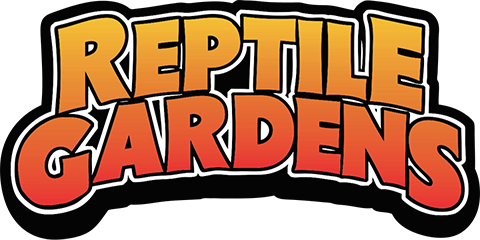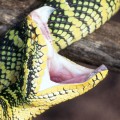Antivenin vs Antivenom
In conversation with friends and Guests it occurred to me recently that the average person knows virtually nothing about antivenoms. Not that most people should, it really doesn't impact their lives. However, I have also found most people are quite fascinated when I tell them about this unique medicine.
Antivenin vs Antivenom
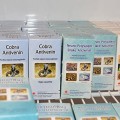 Antivenin inventory
Antivenin inventoryAntivenom is also known as antivenin (sometimes pronounced "antiveneen"). It was originally developed in France in the late 19th century at the Pasteur Institute and so the French word became the most commonly used name for it. Although many of us who have been in the business a long time still use the old term, the more common word these days is antivenom, the English version.
What Does Antivenom Do?
Snake venoms are extremely complex and vary considerably from species to species. In fact, research has shown that a single snake's venom can vary markedly on a daily or, yes, even hourly basis. At any rate, because their effects are so different, I can't go into the details of how each antivenom works. Suffice it to say its purpose is to neutralize venoms so they don't kill you.
Where Do You Get Antivenom?
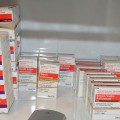 Antivenom supply
Antivenom supplyThere are venom labs in a number of countries around the world that produce specific antitoxins for the snakes in their region or for specific regions of the world where it is needed. Since our collection of deadly snakes is second to none, we need antivenoms from most of the manufacturers, and lots of it. We get antivenoms from Mexico, Costa Rica, Germany, South Africa, Thailand, India, and Australia.
How Do You Get It?
Antivenoms are considered to be an "Investigational New Drug" by the United States Food and Drug Administration (even though they have been around since the late 19th century). So, therefore they are heavily regulated. Anyone buying, keeping, and potentially using antivenom is required to go through an approval process and to have been issued an IND number (Investigational New Drug number).
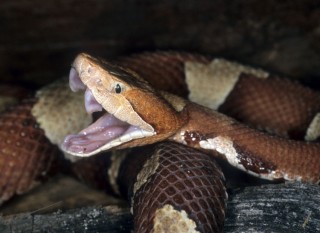 Copperhead
CopperheadBut once you get your IND # you don't just go online and order from Amazon. The next step is to apply for a US government permit to import a specific venom lab's antivenoms, the specific types being requested and quantities of each. Orders from separate labs require separate permit applications. The permit application process can take many months. It requires us to detail what we want and why we want it, provide information regarding what our bite protocol is, how we will be importing it, how we will store it, and how we will dispose of expired antivenoms if we don't use them.
While applying for the import permit we also begin the process of contacting the venom lab to see what antivenoms they have in stock and, critically, what the expiration dates are on the stock we would receive. Some antivenoms are good for only two years. If we order just before a new production run then we could spend a lot of effort and money on antivenom that will expire just a few months after we get it. Therefore, we always try to get the freshest batches possible for the longest shelf life.
There are two main types of antivenom: vials containing liquid antivenom, which is rather delicate and requires constant refrigeration. If a shipment is delayed and the box is left, say, out in the sun on the tarmac or in a hot airport warehouse for too long then its efficacy can be greatly diminished. This is not something you want to find out when you need it. The other type is known as lyophilized which is freeze-dried and is then reconstituted in the vial at time of use. This type is far more stable and can take somewhat warmer temperatures than the liquid type. However, this type is considered by some in the business to be slightly less effective.
As soon as the permit arrives we complete the order with the venom lab and arrange a bank transfer for payment. They arrange the shipping but we have to contact our customs broker who is needed to clear the shipment through US Customs and get the package on to us as quickly as possible.
Because of the lengthy process we usually start working on getting fresh antivenom a year or more before our current stock expires. Once it finally arrives it goes in a special refrigerator that holds only our antivenom stock. When we have the new stock we dispose of our oldest stock as per methods required by US government regulation.
How Much Do You Need and How Much Does It Cost?
Quantities needed to neutralize a bite vary. We try to keep enough antivenom to neutralize a really bad envenomation by each and every species of snake we have. Some of our snakes are so rare that there is no specific antivenom for its bite so we stock up on one that specialists consider close enough to do the job - at least good enough to keep you alive.
The vials vary in size but for example:
- A single vial of Boomslang antivenom costs $5500 and one could require up to 3 vials to counteract a serious bite.
- A King Cobra bite could require 20 vials, although 50 is not unheard of. Fortunately it is a much cheaper antivenom (though also not as effective as others either) at just $40 per vial.
- For a Taipan bite one might need 7 to 10 vials at $2100 per vial. A Gaboon Viper bite could require 20 or more vials which cost $315 each.
The synthetic American antivenom used to treat rattlesnake bites is often priced like a retail commodity with no regulation - a hospital pharmacy can charge whatever they want. We have heard of pharmacies in the US charging up to $10,000 per vial. Not long ago an individual was given 110 vials of antivenom for a prairie rattlesnake bite (although 10 to 20 is more typical for prairie rattlesnake bites)
Then, of course, along with the antivenom costs, you have to add in all the other hospital costs, intensive care and all which in the case of a bad viper bite could easily top a quarter of a million dollars.
Depending on what we need to replace, we normally spend anywhere from $10,000 to
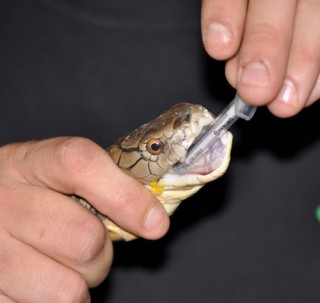 This King Cobra is getting a dose of medication. Notice the large drop of venom.
This King Cobra is getting a dose of medication. Notice the large drop of venom.$50,000 per year on antivenom. I consider it like any other insurance policy, something you must have but hope you never need. The good news: In our 79-year history we have never had to use our antivenom for a bite here at Reptile Gardens. On occasion we send antivenom to hospitals in other parts of the US when some zookeeper, or private individual who keeps venomous snakes, gets bitten.
At the end of each calendar year, we are required to send a detailed and very specific annual report regarding our antivenom stock, what we have on hand, if we used any including details of the use or if we sent it to someone else, what we imported, what we destroyed and how.
JM
